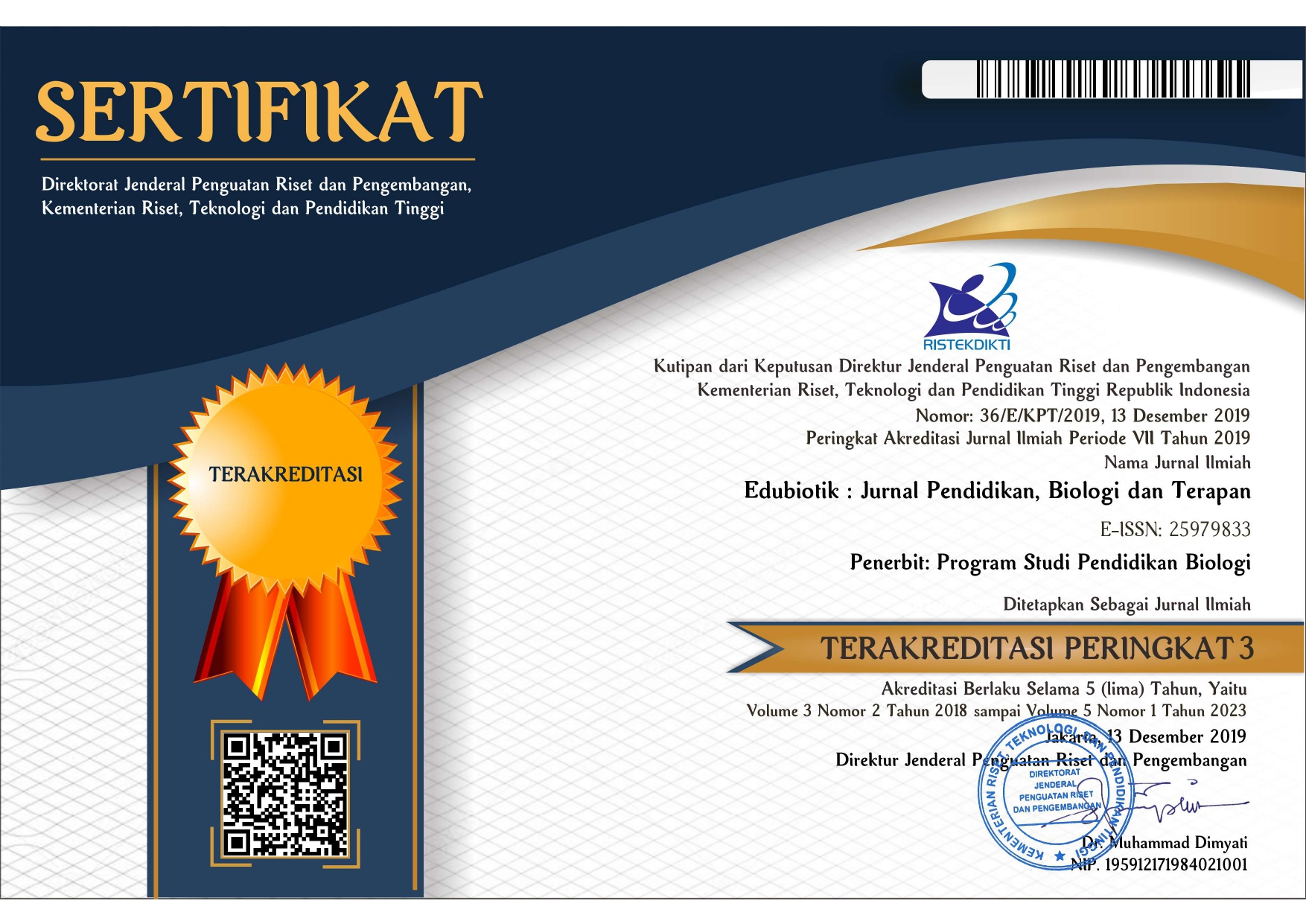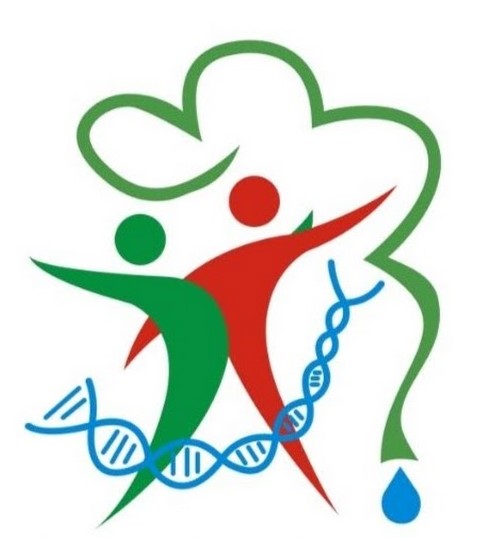The diversity of banana cultivars in East Kalimantan based on morphological characteristic
Abstract
Banana is a plant with nutritious fruit and can help prevent stunting. Banana plants are widely cultivated in East Kalimantan, but the type characterization has not been identified. The purpose of this study was to determine the diversity of banana plants in East Kalimantan and to characterize banana plants based on morphology. This research is explorative in nature by identifying directly in the field the cultivated banana cultivars. Morphological characterization of stems, leaves and fruit was carried out based on the banana description contained in IPGRI-INIBAP/CIRAD. The research instrument is a banana morphology observation sheet which contains parameters: leaf habit, pseudostem color, predominant underlying color of the pseudostem, sap color, blotches at the petiole base, blotches color, petiole canal leaf III, color of leaf upper surface, color of midrib dorsal surface, color of leaf lower surface, color of midrib ventral surface, wax on leaves. The result shows that at East Kalimantan is found 12 types of banana cultivars were found, Talas bananas, Rutai bananas, Kepok bananas, Mas bananas, Morosebo bananas, Tanduk bananas, Susu bananas, Maulin bananas, Red bananas, Ambon bananas, Raja bananas, and Cavendish bananas.There are variations in the morphological characteristics of banana plants, leaves and fruit that can characterize each banana.
References
Ambarita, M. D. Y., Bayu, E. S., & Setiado, H. (2016). Identifikasi karakter morfologis pisang (Musa Spp.) di kabupaten deli serdang. Jurnal Agroekoteknologi Universitas Sumatera Utara, 4(1), 1911–1924. https://doi.org/10.32734/jaet.v4i1.12404
Barhanpurkar, S., Kumar, A., & Purwar, R. (2015). Charcterisation of banana pseudostem sap used as a mordant for dying. International Journal of Polymer and Textile Engineering, 2(3), 1–7. https://doi.org/10.14445/23942592/ijpte-v2i5p101
Basak, S., Saxena, S., Narkar, R., & Mahangade, R. (2015). Banana pseudostem sap : A waste plant resource for making thermally stable cellulosic substrate. Journal of Industrial Textiles. https://doi.org/10.1177/1528083715591580
Deng, G., Zhang, S., Yang, Q., Gao, H., & Sheng, O. (2021). MaMYB4, an R2R3-MYB repressor transcription factor , negatively regulates the biosynthesis of anthocyanin in banana. 11(January), 1–14. https://doi.org/10.3389/fpls.2020.600704
Fahrasmane, L., Parfait, B., & Aurore, G. (2014). Bananas, a source of compounds with health properties. Acta Horticulturae, 1040(April), 75–82. https://doi.org/10.17660/ActaHortic.2014.1040.9
Hapsari, L., & Lestari, D. A. (2016). Fruit characteristic and nutrient values of four Indonesian banana cultivars (Musa spp.) at different genomic groups. Agrivita, 38(3), 303–311. https://doi.org/ 10.17503/agrivita.v38i3.696
Hassan, H. A., Ghazali, M. J., Zainuddin, N. M., & Azhari, C. H. (2018). Kesan lilin ke atas sifat hidrofobik permukaan daun pisang. Jurnal Kejuruteraan, 29(1), 1–7. https://core.ac.uk/outputs/158272062
International Plant Genetic Resources Institute- International network for the Improvement of Banana and Plantain/ Center de Cooperation Internationale Pour le Development. (1996). Descriptors for Banana (Musa spp.). https://doi.org/10.22146/teknosains.7973
Koch, K. (2008). The hydrophobic coatings of plant surfaces : Epicuticular wax crystals and their morphologies , crystallinity and molecular self-assembly. 39, 759–772. https://doi.org/10.1016/ j.micron.2007.11.010
Kurnianingsih, R., Ghazali, M., & Astuti, S. P. (2018). Karakterisasi morfologi tanaman pisang di daerah lombok. Jurnal Biologi Tropis, 18(2). https://doi.org/10.29303/jbt.v18i2.790
Li, X., Li, Y., Zhao, M., Hu, Y., Meng, F., Song, X., & Tigabu, M. (2021). Molecular and metabolic insights into anthocyanin biosynthesis for leaf color change in chokecherry (Padus virginiana). https://pubmed.ncbi.nlm.nih.gov/34639038/
Nata Suharta. (2010). Karakteristik dan permasalahan tanah marginal dari batuan sedimen masam di kalimantan. Jurnal Litbang Pertanian, 29(4), 139–146. https://ejurnal.litbang.pertanian.go.id/index. php/jppp/article/view/7760/6724
Ningrum, N. P., Hidayatunnikmah, N., & Rihardini, T. (2020). Cegah stunting sejak dini dengan makanan bergizi untuk ibu hamil. E-Dimas: Jurnal Pengabdian Kepada Masyarakat, 11(4), 550–555. https://doi.org/10.26877/e-dimas.v11i4.5616
Pangestika, A. I., & Srimiati, M. (2021). Pemanfaatan kulit pisang kepok (musa paradisiaca ) dalam pembuatan bolu kukus. Nutri-Sains: Jurnal Gizi, Pangan Dan Aplikasinya, 4(1), 39–50. https://doi.org/10.21580/ns.2020.4.1.4132
Poerba, Y. S., Martanti, D., Fajarudin, A., Herlina, Handayani, T., & Witjaksono. (2018). Deskripsi Pisang Koleksi Pusat Penelitian Biologi LIPI. LIPI Press. http://penerbit.lipi.go.id/data/znaskah 1538239167.pdf
Rahmawati, M., & Hayati, E. (2013). Pengelompokan berdasarkan karakter morfologi vegetatif pada plasma nutfah pisang asal kabupaten aceh besar. Jurnal Agrista, 17(3), 111–118. http://jurnal.unsyiah.ac.id/agrista/article/view/1496/1388
Razie, F., & Nisa, C. (2016). Respon pertumbuhan pisang talas ( Musa paradisiaca var . sapientum l .) hasil aklimatisasi terhadap dosis pupuk kandang kotoran ayam dan pupuk npk di lahan gambut barito kuala. 2008, 994–1001. https://repo-mhs.ulm.ac.id/handle/123456789/5682?show=full
Rizal, M., & Triwidyawati, A. (2015). Prospek pengembangan pisang kepok di Kabupaten Kutai Timur, Kalimantan Timur. 1(Djohar 1999), 2006–2010. https://doi.org/10.13057/psnmbi/m010826
Sihotang, E. S., & Waluyo, B. (2021). Keanekaragaman tanaman pisang (musa spp) di kecamatan secanggang, kabupaten langkat, sumatera utara. Agro Wiralodra, 4(2), 36–41. https://doi.org/10.31943/agrowiralodra.v4i2.66
Sunaryo, W., & Mulyadi, A. (2019). Genome group classification and diversity analysis of talas and rutai banana , two local cultivars from East Kalimantan , based on morphological characters. Biodiversitas, 20(8), 2355–2367. https://doi.org/10.13057/biodiv/d200834
Tanaka, Y., Sasaki, N., & Ohmiya, A. (2008). Biosynthesis of plant pigments: anthocyanins , betalains and carotenoids. The Plant Journal, 54, 733–749. https://doi.org/10.1111/j.1365-313X.2008.03447.x
Yazew, T. (2022). Therapeutic food development from maize grains , pulses , and cooking banana fruits for the prevention of severe acute malnutrition. The Scientific World Journal, 2022. https://www.hindawi.com/journals/tswj/2022/3547266/





.png)
2.png)

1.jpg)


